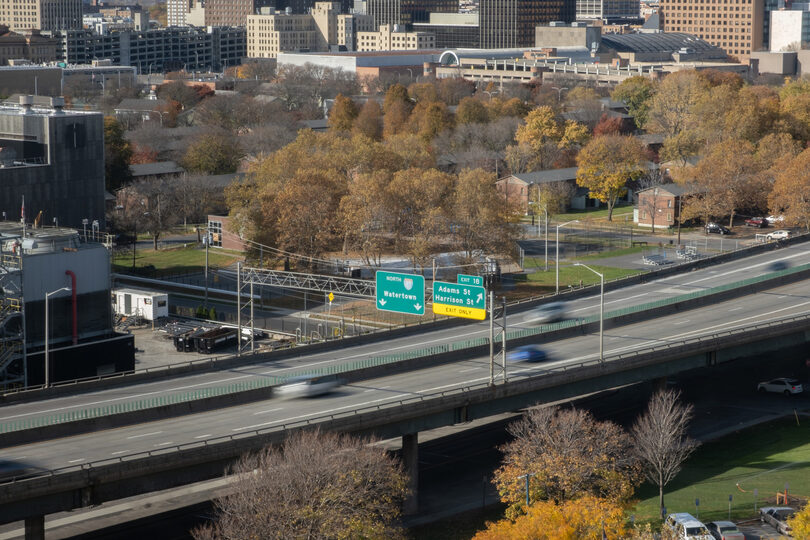City’s $29.7M loss of guaranteed funding halts East Adams revitalization

Under the Trump administration’s megabill, the city of Syracuse lost its federal grant for rebuilding the East Adams neighborhood. Syracuse housing officials are scrambling to fill funding gaps for projects. Malcolm Taylor | Staff Photographer
Get the latest Syracuse news delivered right to your inbox.
Subscribe to our newsletter here.
The city of Syracuse lost a nearly $30 million federal grant aimed at rebuilding the East Adams neighborhood.
The neighborhood, historically one of Syracuse’s most neglected, lost the funds earlier this summer under President Donald Trump’s administration’s megabill, also known as the “One Big Beautiful Bill Act.” The loss of funds was part of a $180 million federal grant under the Reconnecting Communities Pilot Grant Program.
The East Adams revitalization project is working to reverse the displacement of 1,300 families segregated by the I-81 viaduct, creating a physical racial division throughout the city.
In March 2024, $150 million was allocated to the I-81 Viaduct project, and exactly $29.7 million to the East Adams neighborhood redevelopment, I-81 Project Director Joe Driscoll said. Because of the I-81 project’s significant progress in construction, Driscoll said it will not lose any funding.
The East Adams neighborhood project was only initially given $300,000, with the rest pending on a National Environmental Policy Act environmental review, where federal agencies assess the environmental effects of proposed projects before funding or approving them.
The remaining funding was cut under Trump’s megabill before the review could be completed.
“It’s still a question mark on how we’re going to rebuild those streets and that infrastructure for the residents of the 15th ward,” Driscoll said.
The East Adams neighborhood’s $1 billion revitalization includes the redevelopment of public housing, though neighborhood and public architecture are specifically impacted by the grant revocation, said Sarah Walton, the director of East Adams Neighborhood Redevelopment.
The funding was granted through the Neighborhood Access and Equity Grant Program, a federal initiative that mitigates transportation burdens. The $29.7 million would have been used to complement East Adams’ new housing infrastructure by building new sidewalks, roads, landscaping and lighting.
Former President Joe Biden’s administration created the NAE Grant Program to fund transportation projects, receiving funding through the Inflation Reduction Act. However, Trump’s July signing of his megabill cut funding for “radical and wasteful government DEI programs.”
The loss of funding is expected to increase the workload of nonprofit CNY Fair Housing, an organization working to investigate and act on cases of illegal housing discrimination, Policy Manager Alex Lawson said.
Lawson works with communities, including the East Adams neighborhood, to combat housing discrimination by advocating for equitable community development. The funding loss and halt in construction could increase the number of housing discrimination cases the organization sees, he said.
“(The neighborhood has) borne the brunt of government-led discriminatory housing policy in the past, the destruction of an entire community for the construction of a highway on the basis of race, almost explicitly,” Lawson said.

Joe Zhao | Senior Staff Photographer
CNY Fair Housing works on legislation and education to prevent housing discrimination in the East Adams neighborhood. The nonprofit has feared its housing advocacy efforts would be affected by Trump’s cuts to grants for diversity, equity, inclusion and accessibility initiatives.
Lawson said the funding would’ve contributed to an improved quality of life for residents, creating housing opportunities and better sidewalks.
Having written the original $180 million grant application, Walton said she believes the funding loss will “heavily” impact the project and may create setbacks with its design and construction moving forward.
“More specifically, it’s $29.7 million that has been recaptured, which was the city’s portion of the overall grant to pay for public streets and public infrastructure,” Walton said.
With the new housing being built, streets and public infrastructure also needs to be funded, he said.
The cut in funding has the redevelopment of East Adams searching for new means of sourcing.
“Of course, we’re going to have to think about the timing of how fast we were going to be able to do things, and we may not be able to make as beautiful or as comprehensive on the street upgrades as we once imagined, without the kind of funding that we need,” Walton said.
Walton and the partners helping rebuild the East Adams area remain hopeful in their search for alternative funding.
The city recently asked for $10 million from New York state to recover from the loss in funding, and hopes to coordinate with partners in building new infrastructure after the I-81 teardown. The city has also sought funding through the state’s pro-housing supply.
“We have seen other cases through other government agencies where there has been a withdrawal of funds that has been challenged and sometimes effectively so,” Walton said. “I do remain hopeful that we’ll figure out a way to keep the momentum high on this project.”.



